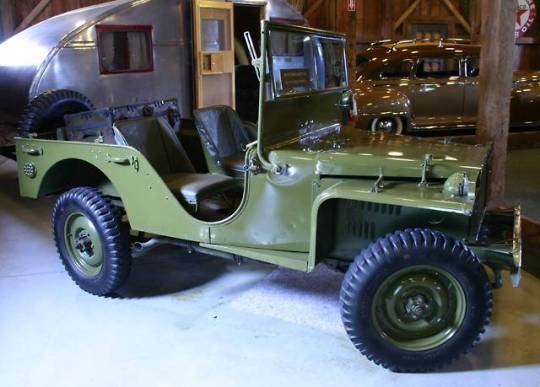#Bantam BRC
Explore tagged Tumblr posts
Text
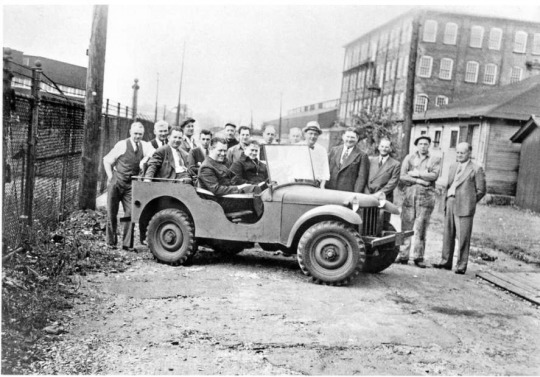
The men who developed the jeep pause to commemorate the event outside the Bantam car factory in Butler, Pennsylvania. The prototype was delivered to the Army.
Date: September 21, 1940
source, source
#Jeep#Bantam Reconnaissance Car#Bantam BRC#Bantam#BRC#BRC Pilot#Archetype#Prototype#Military Jeep#Blitz Bugy#United States Army#U.S. Army#US Army#Army#Bulter#Pennsylvania#factory#September#1940#interwar period#my post
149 notes
·
View notes
Text
How to make a Bantam smile
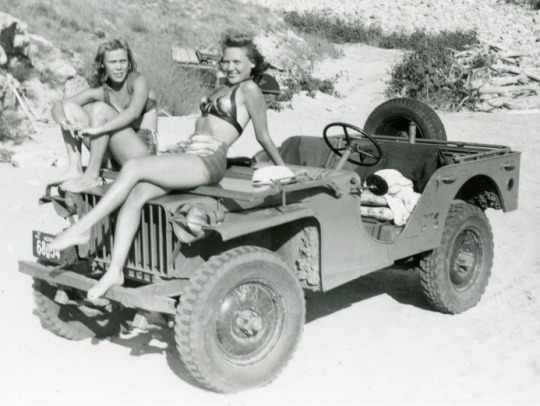
Bantam BRC-40 Jeep
47 notes
·
View notes
Text
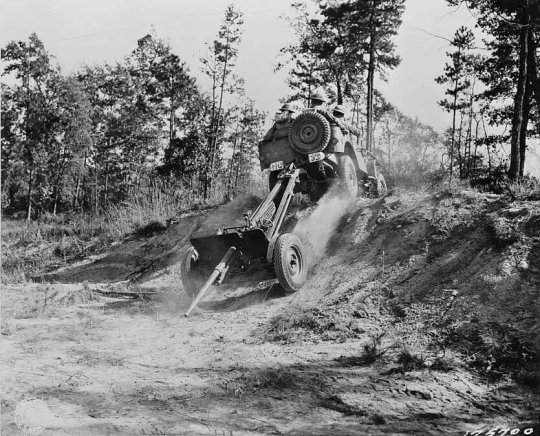
Jeep Bantam BRC 40 tractant un canon antichar M3 de 37 mm au cours d'un test – Wadesboro – Caroline du Nord – Etats-Unis – Novembre 1941
©Library of Congress – LC-USW33-027847-ZC DLC
#WWII#véhicule militaire#military vehicle#véhicule de transport#transport vehicle#jeep#american bantam#bantam#bantam brc 40#canon antichar#anti-tank gun#37 mm gun m3#wadesboro#caroline du nord#north carolina#états-unis#usa#11/1941#1941
10 notes
·
View notes
Photo
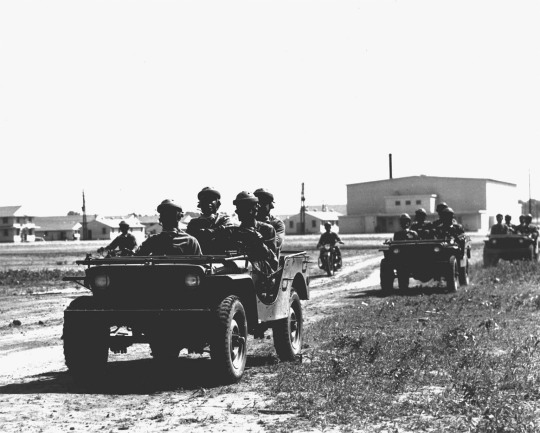
Bantam BRC-40, black soldiers of the US 9th Cavalry Regiment
10 notes
·
View notes
Photo

This was the first Jeep upon completion September 21 1940 at the Butler Pennsylvania plant after a 49 day build. It’s an amazing story of pride drive and ingenuity. It’s called the BRC. Bantam reconnaissance car. Look at the pride on the face of them builders. Impacts us to this day.
189 notes
·
View notes
Text
Warbirds over the beach 2016

Warbirds over the beach 2016 how to#
Warbirds over the beach 2016 generator#
Whilst the Thunderbirds are based at Nellis AFB in Nevada, the Blue Angels are actually based at NAS Pensacola in Florida’s Panhandle. Two of America’s top military aerobatic display teams, the United States Air Force Thunderbirds flying Lockheed (General Dynamics) F-16 Fighting Falcons and the United States Navy Blue Angels flying Boeing (McDonnell Douglas) F/A-18E/F Super Hornets regularly perform at some of Florida’s Air Shows. Air Demonstration Teams visiting Florida in 20 There are plans to re-open as a much larger and more aviation themed attraction in the future. The nearby Fantasy of Flight museum at Polk City used to offer daily (Thursday through Sunday) aerial demonstrations subject to the weather but they shut the main museum to the general public on Apand are currently operating a seasonal interim museum with joy rides in vintage biplanes on the days the museum is open. In the end this was cancelled as well and it now looks like it has been replaced by the Space Coast International Air Show In October 2019 the Board of Directors of the Valiant Air Command museum voted on cost grounds to postpone the 43rd Space Coast Warbird Airshow to 2021 so there was no Space Coast Warbird Airshow in 2020. Air Shows at Florida Air MuseumsĪ couple of Florida’s air museums like the Valiant Air Command at Titusville (Space Coast Warbird Airshow, formerly TICO Warbird Airshow) and the Florida Air Museum in Lakeland (Sun 'n Fun Fly-In and Convention) host annual air shows each Spring. Experimental Aircraft Association (EAA) Ford-Tri-Motor Tourĭue to the COVID-19 pandemic, none of the vintage air tours came to Florida in 2021.Experimental Aircraft Association (EAA) Aluminium Overcast Tour.Commemorative Air Force (CAF) AirPower History Tour.Wings of Freedom Tour by the Collings Foundation.For a fee, you can often get a ride in one of them. This is an opportunity to see real vintage and World War II aircraft in flight rather than just as static museum exhibits. Over the space of a couple of months they visit a number of regional airports throughout the state. Though not air shows as such, there are a number of vintage and warbirds aircraft tours that often visit Florida in the spring. NAS Key West Southernmost Air Spectacular NAS Pensacola Open House, Blue Angels Homecoming Air Show NAS Jacksonville Air Show - Birthplace of the Blue Angels Up Up and Away Florida Hot Air Balloon Festival Wings Over Homestead ARB - POSTPONED UNTIL 2023 NAS Key West Southernmost Air Spectacular - POSTPONED UNTIL 2023 Gator Fly In and Armed Services Appreciation Day Favourite Things To Do In Central Florida.
Warbirds over the beach 2016 generator#
↳ Willys Go Devil Engine Based GENERATOR SETS and COMPRESSORS(Includes Hobart Bros.↳ Jeeps used by: USMC, USN, USCG (-NO EBAY-CRAIGSLIST-COMMERCIAL SALES-).↳ Willys MB & Ford GPW, For Sale Section.G503, WWII Jeeps, Willys MA, Willys MB, Ford GP, Ford GPA, Ford GPW, Bantam BRC.
Warbirds over the beach 2016 how to#
if you ever want to join the "rare and crazy breed" you can always attend one of our jump schools and we'll teach you how to do it! In the mean time look for us to perform at the Mid-Atlantic Air Museum's airshow in June in Reading, Pennsylvania and at the Warbirds Over Monroe event in November in Monroe North Carolina which is Tinker Belle's home town.Īnd. We have been treated very well by everyone at the museum these past years and look forward to returning next year. We were looking forward to a repeat appearance this year as well but it looks like the museum's budget won't allow it. So there is historical precedent for jumping from her. As I'm sure you know, the C-46 was used not only as a transport aircraft flying the "Hump" during WWII but also as a jump platform for the "Operation Varsity" jumps. Tinker Belle is a a great aircraft and her crew and owners are the best. That is why we were outfitted as Fallshirmjaeger but jumped a US aircraft. Last year we were scheduled to do it again but the aircraft had some difficulties so we jumped from Tinker Belle instead (the show must go on.). As far as I know, the only group to make static line parachute jumps from a Ju52 since the war. We do traditionally jump US but a few years ago had the rare privilege of jumping as Fallshirmjaeger from the Museum's Ju52. The same group that has been jumping at this show for several years now. I'm a member of the WWII Airborne Demonstration Team.

0 notes
Photo

The 37mm GMC T2 tank destroyer based on the BRC-40 Bantam Reconnaissance Car.
160 notes
·
View notes
Photo

The first Jeep model, the Bantam Reconnaissance Car (BRC-40), photographed during Army testing, 1941. (Work on a hand-built prototype had begun on July 17, 1940, and was delivered for Army testing on September 23, 1940.) [654 x 531] Check this blog!
8 notes
·
View notes
Text
JEEP CHEROKEE 2020: 10 THINGS TO KNOW

Slightly redesigned in 2019, the Cherokee remains a popular Jeep. If we notice especially the Wrangler on our roads, without roof, without doors and sometimes even without shoes in the driver’s feet, the Cherokee is fighting hard not to fall off the podium. Add to that a pedigree that isn’t worm-eaten and you have a recipe for success that even 10 things to know don’t fully explain. But you can always try…
1 Once upon a time
When the United States entered World War II, it decreed that it would need a compact all-terrain vehicle. Two companies raise their hands: American Bantam and Willys-Overland.
The army considered the BRC (Bantam Reconnaissance Car) prototype interesting but it did not have enough torque and the military doubted that the company would be able to provide the required quantity. They then passed on the Bantam design to Willys and Ford, asking them to do better. Their prototypes: the Ford GP and the Willys MA. When a Willys engineer finally slipped a powerful “Go Devil” under the hood, the Willys Model MB won the day.
In production, the army put Willys and Ford to work, while Bantam, after a few units, moved on. The result was the Model MB and the Ford GPW (for Government, P stands for the 80″ wheelbase, and W is a salute to Willys’ design).
2 We are still looking for
Where does the word Jeep come from? As the manufacturer himself avoids clarifying the question, no doubt to thicken the mystery, the suppositions rain down. For some, the name refers to Eugene the Jeep, a comic book animal linked to Popeye and Olive Oyl. He was magical, able to “move anywhere and do anything”, just the pretensions of a Jeep. In short, teleportation before its time!
For others, the name derives from the Ford GPW, although the meaning “General Purpose” of GP is disputed.
A third theory: Jeep would be the acronym for “Just Enough Essential Parts”, the vehicle being the assembly of “just enough essential parts”. Make your choice!
3 What kind ?
By the way, should we say a Jeep or a Jeep? On its website www.jeep.ca, Chrysler describes the Jeep Cherokee, no doubt because it goes straight ahead, goes through everything, is not afraid of anything; in short, it’s manly! Just as we don’t say the RAM, which is a van… Moreover, as the word “jeep” has become generic over time, like “fridge” and “kodak”, we often write the jeep in reference to any all-purpose vehicle. And without capital letters as long as the brand is not mentioned. Come to think of it, in parallel with the current news that puts the spotlight on non-gender individuals, the Jeep is perhaps the unisex vehicle of choice…
4 To me! No, to me!
As early as 1943, Willys applied for copyright of the Jeep name but the courts ruled that the original design belonged to Bantam. Never mind, Willys marketed the CJ-2A in 1945, the first “Civilian Jeep” intended for the general public. And then, since Willys was the only post-war company interested in assembling jeeps, it was finally granted the trademark in 1950.
5 The waltz of the owners
The CJ gives the starting signal for an avalanche of by-products: the Jeep Station Wagon (1946), the Jeep Truck (1947), the ancestor of the Gladiator, the Jeepster (1948). In 1953, Kaiser Motors bought Willys, which became Kaiser-Jeep in 1963. American Motors Corporation (AMC) acquired Kaiser’s Jeep division in 1970. Renault begins to invest in AMC in 1979 before Chrysler Corporation buys AMC in 1987, essentially to get its hands on Jeep (Chrysler will drop all other AMC activities).
6 Follow the guide!
At www.jeep.ca to shop for your Cherokee 2020, you will find nine models. Actually, there are six and three packages (North Altitude, Trailhawk Elite and High Altitude). The six versions are Sport, North, Trailhawk, Limited and Overland. Uh, Mr. Columnist, that makes five… The North splits up, as it can be had in 4×4 and 4×2, the only model in the family to be satisfied with front-wheel drive if that’s what you want.
All other versions come standard with all-wheel drive, but it’s not even that simple yet. There are, in fact, three kinds of 4x4s for the Cherokee…
For Sport 4×4, there’s no choice, it inherits the Active Drive I system. The North, Limited and Overland variants come standard with Active Drive I but can be upgraded to the optional Active Drive II. Finally, the Trailhawk comes with Active Drive Lock, a system exclusive to the Trailhawk.
7 Him or him?
Let me guess your next question: what are the differences between these three 4x4s? The Active Drive I is not a constant drive, like Subaru for example. Rather, it allows the rear axle to be uncoupled if electronic sensors judge that road conditions do not require all-wheel drive. You then drive in 4×2 mode to save fuel. The system reverts back to 4×4 whenever necessary, without driver intervention.
Active Drive II adds low speed all-wheel drive, which locks the driveshafts on demand to ensure you’re all-wheel drive. It’s great for getting out of a rut or for towing. Plus, Cherokee’s ground clearance with Active Drive II increases by 1″ (2.5 cm).
Finally, the Active Drive Lock system uses the capabilities of the Drive II and allows the rear differential to lock, which sends equal torque to each of its wheels. For serious off-road enthusiasts.
8 Trio of mills
In addition to the two well-known engines, the 271-hp 3.2L V6, a washed-down version of the 3.6L Pentastar, and the 184-hp 2.4L Tigershark 4-cylinder, FCA recently added a 2.0L, 270-hp, turbocharged 4-cylinder that’s more expensive than the V6 and similar to the one that rumbles under the bonnets of the Wrangler and Alfa Romeo Giulia and Stelvio.
This trio of machines is backed by a 9-speed automatic transmission in place since 2014, which was groundbreaking, but has since come in for criticism because of its frequent hesitations.
Finally, although the base 2.4L can only tow 2000 lbs, the V6 manages with 4500 lbs (2041 kg), 500 lbs more than the turbo.
9 A forerunner
The Cherokee’s career began in 1974 as a 2-door version of the Jeep Wagoneer (1962 to 1991), while ousting the disappointing Jeepster Commando. The 4-door version of the Cherokee was born in 1977. To appeal to a younger customer base than the venerable Wagoneer, marketing gurus coined an expression to define the newcomer: Sport Utility Vehicle (SUV). These three words have never left our automotive lexicon!
10 A long C.V.
To underline its 2nd generation (1984), the Cherokee abandons ladder construction in favour of a monocoque body, another first. The public loved this idea, which gave the comfort of a car to a “truck”. Rivals take notes.
The Cherokee’s popularity is such that when the time comes for the 3rd generation (2002 vintage), Chrysler launches the Grand Cherokee while its famous little brother becomes the Liberty in North America (but keeps the Cherokee name elsewhere in the world). Then begins its period of compact SUVs, until the Compass/Patriot duo makes it into the even smaller one in 2007.
A year later, the fourth generation was greeted, still under the Liberty name, while Dodge entered the fray with a twin brother named Nitro.
With the 5th generation (2014) begins the crossover period: the Liberty name is retired, the Cherokee name is revived and the vehicle is slightly enlarged to justify the arrival of the Jeep Renegade.
11 Signature visuelle (boni !)
The famous seven-bar vertical grille that makes a Jeep’s front grille as recognizable as a Rolls-Royce’s was originally new, based on Ford’s original design for its GPW. To better cook a hamburger says the legend…
0 notes
Photo





Bantam #1 top left, the very first prototype light 4x4 truck built by Bantam Car Company for the US Military in 1940. The center photo is of the BRC-1007 prototype. Other photos are of the finished design, BRC-1. This would be built by Willys Overland (theJeep MB) and Ford (the GPW) for the war. During that time over 500,000 of these were built.
156 notes
·
View notes
Text
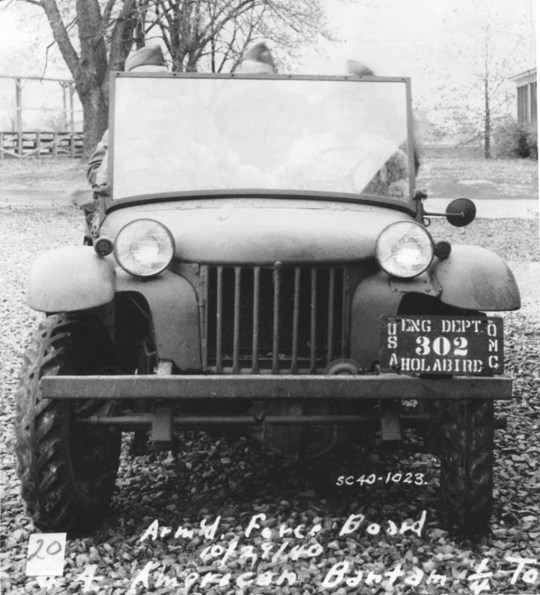
"Taken at Camp Holabird, this view of the Bantam prototype clearly shows the graceful curved fenders. These soon gave way to the characteristic flat fenders. The Reconnaissance Car appears to be heavily burdened by the five men inside it."
source
#Jeep#Bantam Reconnaissance Car#Bantam BRC#Bantam#BRC#BRC Pilot#Archetype#Prototype#Military Jeep#Blitz Bugy#United States Army#U.S. Army#US Army#Army#October#1940#interwar period#my post
101 notes
·
View notes
Photo

Jeep Bantam BRC 40 tractant un canon antichar M3 de 37 mm au cours d'un test – New River – Caroline du Nord – Etats-Unis – 1941
Photographe : U.S. Army Signal Corps
©Library of Congress - LC-USW33-027832-ZC
#WWII#Véhicule militaire#Military vehicle#Véhicule de transport#Transport vehicle#Jeep#Jeep Bantam#Canon antichar#Anti-tank gun#Canon antichar M3 de 37 mm#M3 37 mm#New River#Caroline du Nord#North Carolina#Etats-Unis#United States of America#USA#1941
85 notes
·
View notes
Text
I Live - I Ride - I'm motorcar - The motorcar whole
I Live - I Ride - I'm motorcar - The motorcar whole
jeep,jeep wrangler,jeep wrangler review,jeep gladiator,jeep grand cherokee,jeep review,jeep rubicon,jeep jl,jeep xj,new jeep wrangler,jeep wrangler 2019,2019 jeep wrangler,mini jeep,jeep truck,jeep gladiator review,jeep pickup,https://ift.tt/2TQqy8n cherokee,i live - i ride - i'm motorcar - the motorcar whole,jeep wrangler jl,jeep gladiator 2020,2020 jeep gladiator,jeep lj,jeep cj,jeep tj,jeep wrangler rubicon,modified jeep wrangler,jeep gladiator rubicon,jeep mpg
Jeep may be a four-wheeled drive vehicle of the common fraction to one-and-one-half-ton capability for intelligence activity or different army duty. A term applied to the bantam-cars, and infrequently to different motorcars (U.S.A) within the air force, the flight simulator, within the soldiers, the ½-ton command vehicle, conjointly observed as "any tiny plane, helicopter, or gadget". - Words of the Fighting Forces by Clinton A. Sanders
Jeep secured the fans of this automotive participating them to make clubs everywhere the globe to give-and-take their know-how and familiarities with this whole. WHO would not love this automotive particularly if your comfort lovers seeking extraordinary journeys? For over seventy years, the motorcar whole continues to ask individuals to measure life to the fullest that lets the owner have a way of security to return across any journey proudly and confidence through their full line of vehicles.
A Blast from the Past
It all began with the necessity for a quick and light-weight intelligence activity (military observation of a part to find AN enemy or ascertain strategic features) vehicle that might move effectively on any parcel to exchange the U.S Army's motorbike and changed Ford Model T-vehicles in July 1940. the military opened a bid on production whereby they invited over a hundred makers and established an inventory of car specifications.
Initially, solely Willys-Overland and Yankee Bantam automotive producing Company responded. However, Ford Motor Company entered the image a touch later. From then on the 3 firms competed over the receiving of the remunerative government contract. In forty-nine days, the Bantam Company designed its field automotive whereas every company has made prototypes for testing in an exceeding record of your time.
The 3 firms were granted to make seventy sample vehicles when the delivery of their prototypes to the military within the summer of 1940. Willys-Overland designed Willy's Quad whereas Ford developed its Model general practitioner (General Purpose), conjointly called the Pygmy.
In the Gregorian calendar month 1940, the military took possession of those vehicles that exceeded their specifications however shortly realized the necessity to boost the limit for future spherical of vehicles.
In March 1941, another spherical of the contract was free by the military. every one of the 3 firms was to supply one,500 vehicles. Bantam designed Model forty BRC vehicles, Ford improved general practitioner Pygmies, whereas Willis-Overland referred to as their vehicles as Quads. when a series of testing, analysis, and assessment, the U.S Army had elite the first manufacturer to be Willys-Overland.
Origin of the Name
Lots of explanations on wherever the word "Jeep" originated are existing. Some suggest that they informally named it when Eugene the motorcar, a personality within the Popeye cool animated film for the troopers were therefore transfixed with the new vehicles. the foremost wide known theory tho' is that the military designation general practitioner (for Government functions or General Purpose) was unintelligible into the word motorcar whereas the President of Willys-Overland, Joe Frazer, claims to possess coined the term motorcar by slurring the initials G.P for his or her model vehicle. Willys-Overland was conjointly the corporate WHO filed the applying of the first trademark brand-name in February 1943.
The motorcar whole Vehicles these days
After all the continual testing and evaluations since the Forties, from the primary civilian motorcar vehicle up to the motorcar Cherokee, from the prototypes up to the all-new motorcar whole models, we will finally say that technology has gone manner on the far side the standards. For over seventy years, the motorcar whole created countless sales and continues to boost the formula delivering the right balance of on-road performance and cross-country capability. The motorcar may be a reliable automotive with many functions together with its sophistication and tasteful style. additionally, there is the legendary acquisition, the selection from luxury and advantage, world category interior and sleek exterior, and therefore the conveyance of safety, convenience, and advanced technology with improved fuel economy.
from Blogger https://ift.tt/33GaRoZ via IFTTT
0 notes


